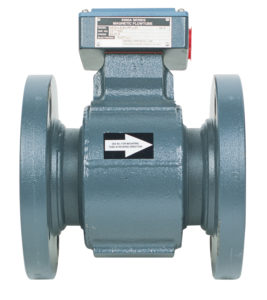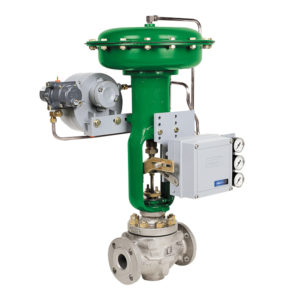By Walt Boyes
What is a Magmeter?
 Electromagnetic flow meters, commonly called magmeters, are pretty close to the perfect flowmeter in many ways. As long as the fluid is conductive, a magmeter will measure flow from about one foot per second to about 30 feet per second in a pipeline, with an accuracy better than 1% of indicated flow rate. They operate based on Faraday’s Law. When a moving conductor (the fluid) passes through a magnetic field perpendicular to the direction of flow, a very small current is created on a set of electrodes set at right angles to the flow. This small current is proportional to the average velocity of the fluid in the pipe. The fact that the magmeter measures the average velocity in the entire pipe is one of the main reasons that magmeters are so accurate.
Electromagnetic flow meters, commonly called magmeters, are pretty close to the perfect flowmeter in many ways. As long as the fluid is conductive, a magmeter will measure flow from about one foot per second to about 30 feet per second in a pipeline, with an accuracy better than 1% of indicated flow rate. They operate based on Faraday’s Law. When a moving conductor (the fluid) passes through a magnetic field perpendicular to the direction of flow, a very small current is created on a set of electrodes set at right angles to the flow. This small current is proportional to the average velocity of the fluid in the pipe. The fact that the magmeter measures the average velocity in the entire pipe is one of the main reasons that magmeters are so accurate.
Magmeters can be used to measure clean liquids, like water, and fluids with both dissolved and suspended solids. They are excellent for measuring slurries, too, like lime, and chemical solutions that are often corrosive and somewhat abrasive.
Magmeters for the Pulp and Paper Industry
This is why they are the basic workhorse flow meter in the pulp and paper industry. They are used to measure water flow in many locations in the mill. They are used to measure black, white, and green liquors, pulp stock, flows on the paper machine itself, and a variety of chemical flows, like chlorine dioxide, hydrogen peroxide, sodium hypochlorite, and others.
Magmeters use a lining to keep from grounding the coils and electrodes to the pipe body. For simple applications, like water, neoprene is used for the liner, and a nickel alloy electrode is sufficient. When you start looking at highly corrosive fluids, the lining and electrode combinations tend to be some form of Teflon® and a corrosion resistant metal like titanium for the electrodes.
Magmeters were originally designed to use an AC current to excite the coils. This created a sine wave output from the electrodes. A problem quickly surfaced, though. If the fluid being measured was anything other than water, the buildup of deposits on the wetted surfaces of the electrodes made the sine wave drift. This meant that the flow measurement would also drift, and accuracy would be reduced.
Magmeters for Black, Green, and White Liquors
As digital electronics improved, most magmeter manufacturers switched to using a DC current to excite the coils. This could be pulsed as a square wave, and it could be “keyed.” That is, when the current was in the off position, the output of the electrodes could be compared to a remembered zero, and the effects of drift could be eliminated. This made magmeters even more accurate than before.
But in the pulp and paper industry, there were some applications where the DC field magmeter didn’t work as well. These applications were the “liquors”—the black liquor, the green liquor, the white liquor. It was some time before vendors figured out the problem. The problem is that these fluids are electrically “live.” That is, they have currents running through them and the impingement of the fibers on the electrodes generates a high amount of noise. The small current output of the DC magmeters were sometimes swamped by the noise. AC meters solved the problem by basically blasting the signal using full line current, and they are often still used in pulp mill applications for that reason. As better DC signal filtering improves, more DC meters will be capable of these measurements.
Automation Service provides expertise, assistance, and can repair or replace your flow meters quickly and economically. Contact us to get started.

Walt Boyes has more than 40 years of experience in the automation industry, including Executive Committee experience in three companies, and board of directors service in both for-profit and not-for-profit companies. Walt is principal in Spitzer and Boyes LLC, a technology consulting firm assisting companies to better market their products in manufacturing and automation. He has contributed to many industry publications as both writer and editor. View Walt’s full bio.

